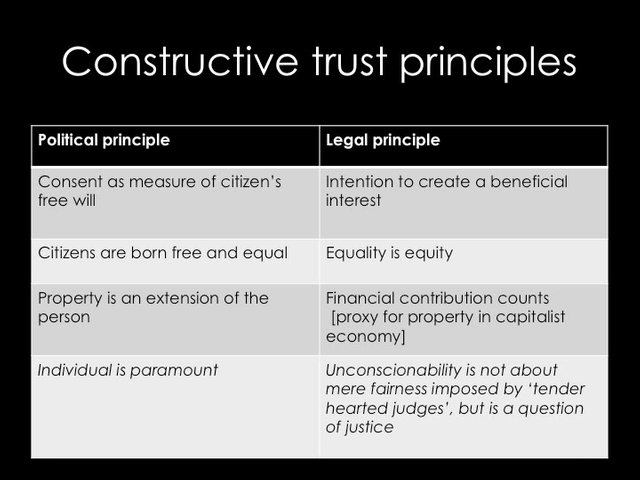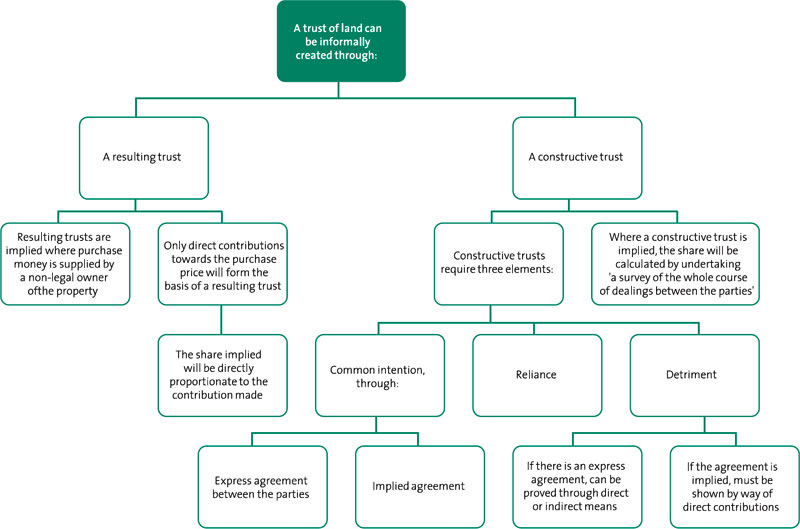Judicial Perspective Surrounding What Is A Constructive Trust Discussed
Judicial Perspective Surrounding What Is A Constructive Trust Discussed
Blog Article
Revealing the Benefits of a Useful Trust in Resolving Recipient Disputes
The concept of a constructive count on arises as a pivotal tool in the detailed realm of recipient conflicts, offering a nuanced solution to conflicts that commonly occur from wrongful residential property retention. By fostering a fiduciary connection in between parties, this equitable remedy not just facilitates quick resolutions however likewise serves to prevent prospective transgression. As we explore the complex advantages of useful trusts, one might start to examine how these systems can reshape the landscape of estate disagreements and contribute to an extra equitable circulation of assets among recipients.
Interpretation of Constructive Trust
A constructive trust fund is regularly established by courts to deal with situations where one event has wrongfully acquired or maintained residential or commercial property that rightfully belongs to one more (What Is A Constructive Trust). This lawful principle is not a traditional trust, as it does not need the procedures typically connected with depend on production, such as a created agreement or the intent of the events involved. Rather, a constructive trust emerges by procedure of legislation, functioning as a fair solution to prevent unfair enrichment
The courts impose a positive trust when it is figured out that one celebration holds residential or commercial property under situations that, in equity and great conscience, should not allow them to retain it. Common scenarios include deceptive activities, breaches of fiduciary obligation, or scenarios where an event has actually obtained property through incorrect methods. The useful trust thus works to protect the legal rights of the rightful owner by making sure that the residential or commercial property is held for their advantage.
As soon as developed, the useful trust fund calls for the event in property of the residential or commercial property to communicate it to the rightful proprietor, therefore remedying the wrongful situation. This system emphasizes the legal system's commitment to fairness and justice in building disputes, highlighting the value of moral conduct in possession and transfer of possessions.
Benefits of Positive Trusts
Positive trusts use several significant advantages in lawful disagreements involving building legal rights. Mostly, they act as an equitable solution, permitting courts to deal with situations where a celebration has wrongfully obtained or retained residential property that rightfully belongs to an additional. This develops a framework for fairness, ensuring that the rightful proprietor is compensated and the unjust enrichment of the culprit is reduced.
Furthermore, constructive trusts can quicken resolution in conflicts over estate assets, therefore reducing the typically controversial and lengthy lawsuits procedures connected with conventional property conflicts. Their flexibility allows courts to customize remedies to fit the certain circumstances of each case, which can bring about more satisfactory outcomes for all events included.
Additionally, positive trust funds promote openness and accountability amongst fiduciaries and beneficiaries, as they need the last to act in the most effective interests of the previous. This strengthens the honesty of fiduciary connections, fostering depend on and participation. Ultimately, by preventing misconduct associated to building possession, useful depends on add to the overall security of monetary and legal systems, guaranteeing that home civil liberties are valued and supported within culture.
Exactly How Constructive Depends On Job

In practice, when a useful count on is imposed, the court determines the residential or commercial property in concern and develops a fiduciary connection straight from the source in between the celebrations included. The celebration more that holds the residential property becomes a trustee, obligated to manage it for the benefit of the rightful owner, called the recipient. This connection is not based upon an official arrangement but rather on the concept of equity, intending to rectify scenarios where one party's gain directly correlates with one more's loss.

Study and Instances
When checking out the functional application of useful counts on, various case research studies illustrate just how courts browse complicated scenarios including unjustified enrichment. One noteworthy instance is * Pettkus v. Becker *, where the Supreme Court of copyright established a constructive trust to fix the unjust enrichment of one event over an additional in a long-lasting partnership. The court identified that the contributions of one partner to the acquisition of residential property warranted the charge of a constructive trust, making certain fair circulation.
An additional considerable example is * Gisborne v. Gisborne *, where the court imposed a constructive trust to attend to the insurance claims of siblings over their departed brother's estate. The court acknowledged the contributions made by the brother or sisters in maintaining the household building, causing a choice that needed the estate to make up those contributions, thus stopping unjustified enrichment.
These instances exemplify how constructive trust funds can properly settle conflicts by concentrating on justness and the avoidance of unjust enrichment. By analyzing the certain payments and conditions of the parties entailed, courts can use useful depend accomplish just end results, inevitably reinforcing the fair Related Site principles underpinning these lawful mechanisms.

Steps to Develop a Positive Count On
To establish a useful depend on, numerous vital steps must be followed to ensure that the case is substantiated and lawfully acknowledged. The complaintant must demonstrate the presence of a fiduciary partnership or a situation that necessitates the charge of a constructive trust, such as fraudulence, unfair enrichment, or a breach of task.
2nd, it is necessary to gather and existing engaging proof that sustains the insurance claim. This includes paperwork and statements that highlight the situations leading to the alleged wrongful retention of home or benefits by the trustee.
Third, the plaintiff should submit a petition in the proper court, verbalizing the premises for requesting the imposition of a positive trust. This application needs to detail the specifics of the connection and the unjustified enrichment that requires the trust fund.
Verdict
To conclude, useful trusts represent a vital equitable treatment in the world of beneficiary conflicts, effectively dealing with wrongful residential property retention and protecting against unfair enrichment. By creating a fiduciary partnership, these trust funds boost transparency and liability among building holders. The expedited resolution of estate disagreements and the frustration of misbehavior add to higher security within economic and legal systems. Eventually, constructive trusts promote justness amongst beneficiaries, ensuring that rightful ownership is preserved and secured.
A constructive trust is often established by courts to deal with circumstances where one party has actually wrongfully gotten or maintained residential property that rightfully belongs to one more.The courts enforce a constructive depend on when it is established that one party holds home under scenarios that, in equity and good principles, should not permit them to maintain it. By inhibiting transgression relevant to home possession, useful counts on add to the overall security of lawful and monetary systems, guaranteeing that home legal rights are respected and promoted within society.
In technique, when a positive count on is imposed, the court recognizes the residential or commercial property in concern and develops a fiduciary connection in between the events involved. What Is A Constructive Trust. The court established that the contributions of one partner to the acquisition of residential or commercial property validated the imposition of a useful depend on, guaranteeing equitable distribution
Report this page